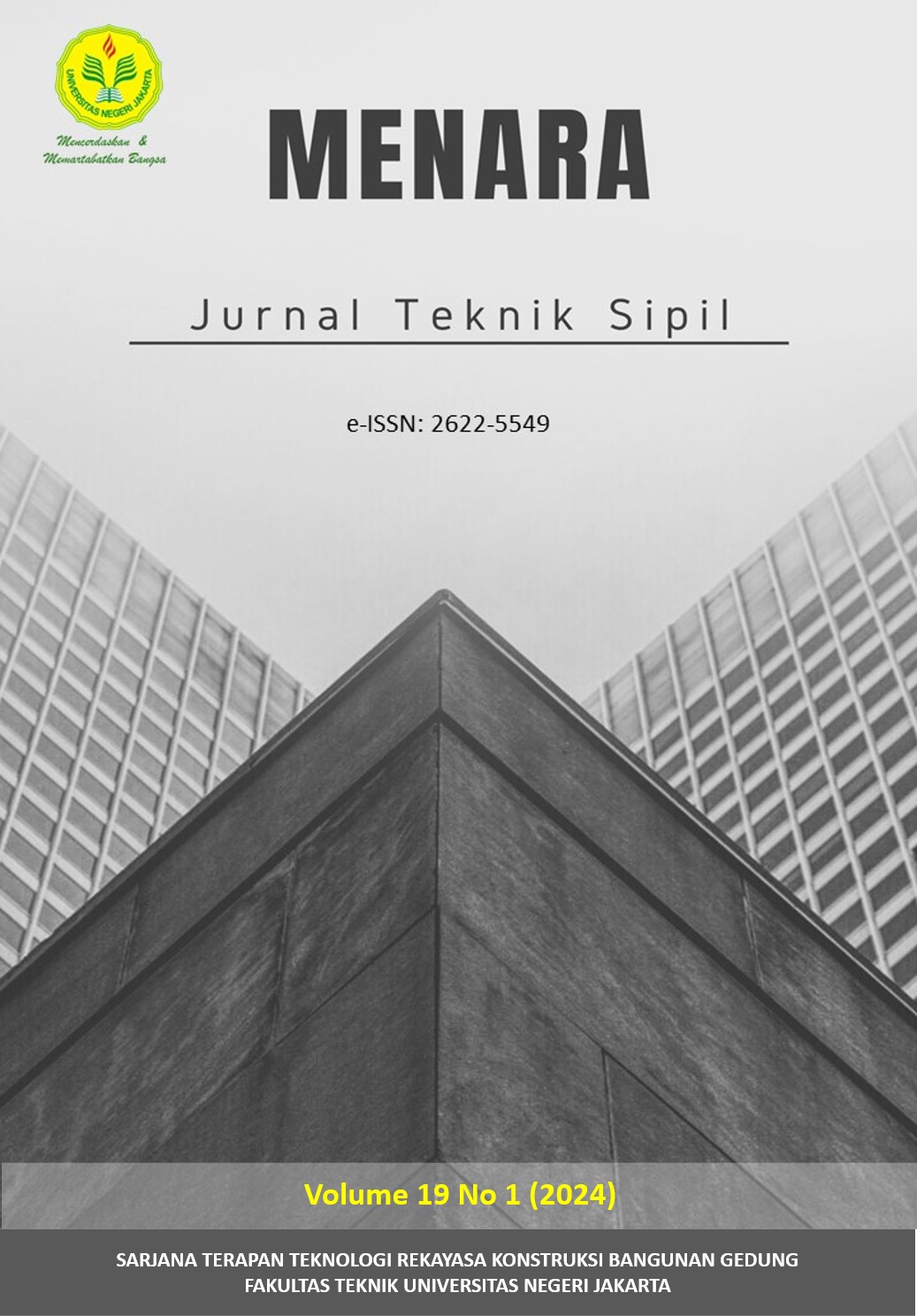UNSUR SENYAWA KIMIA DARI LIMBAH MASKER MEDIS UNTUK MENINGKATKAN KINERJA CAMPURAN ASPAL
DOI:
https://doi.org/10.21009/jmenara.v19i1.38940Keywords:
Asphalt Mixture,Mask,Polypropylene,Silica,WasteAbstract
Masker adalah perlindungan pernafasan yang digunakan sebagai metode untuk melindungi individu dari menghirup zat-zat bahaya atau kontaminan yang berada di udara. Meskipun masker sangat diperlukan untuk menghindari penyebaran virus Corona, namun pembuangan masker mengancam lingkungan. Masker medis terdiri dari tiga lapisan, lapisan luar dan lapisan dalam adalah kain non-woven yang tahan air dan lapisan tengah adalah bahan yang meleleh. Sebagian besar, komposisi kimia dari masker medis adalah polipropilena. Pada review ini akan dibahas penggunaan limbah masker yang mengandung polipropilena sebagai bahan aditif dalam pembuatan campuran aspal. Metode yang digunakan adalah studi literatur dari peneliti terdahulu dan analisis penambahan limbah masker yang mengandung polipripilena yang berpengaruh terhadap campuran aspal. Sumber utama refrensi artikel ini berasal dari Research Gate, Science Direct, dan Google Scholar. Ditemukan bahwa unsur senyawa yang paling dominan pada masker medis adalah Si (Silika) sebesar 59,11%. Penambahan silika pada campuran aspal dapat meningkatkan ketahanan terhadap kerusakan alur, peningkatan nilai modulus, dan umur fatigue.
References
Abbasi, S. A., Khalil, A. B., & Arslan, M. (2020). Extensive Use of Face Masks During COVID-19 Pandemic: (Micro)Plastic Pollution and Potential Health Concerns in The Arabian Peninsula. Saudi Journal of Biological Sciences, 27(12), 3181–3186.
Adam, F., Kandasamy, K., & Balakrishnan, S. (2006). Iron Incorporated Heterogeneous Catalyst From Rice Husk Ash. Journal of Colloid and Interface Science, 304(1), 137–143.
Affifah, H. N., & Zulfa, A. L. (2021). Pra Rancangan Pabrik Masker Bedah (3 Ply) Spunbond Pp Kapasitas 950 Ton/Tahun. Universitas Islam Indonesia.
Akhbar, H. T., Hadi, W., & Daryati. (2019). Kajian Parameter Marshall Dengan Menggunakan Limbah Karet Ban-Dalam Kendaraan Sebagai Bahan Tambah Pada Campuran Lapis Aus Permukaan Aspal Beton (Ac-Wc). Menara: Jurnal Teknik Sipil, XIV(2), 46–51.
Al-Amri, F. (2013). Studi Perbandingan Penggunaan Aspal Minyak Dengan Aspal Buton Lawele Pada Campuran Aspal Concrete Base Course ( Ac-Bc ) Menggunakan Metode Marshall Test. Radial, 4(2), 181–190.
Ali, M., Opulencia, M. J. C., Chandra, T., Chandra, S., Muda, I., Dias, R., Chetthamrongchai, P., & Jalil, A. T. (2022). An Environmentally Friendly Solution for Waste Facial Masks Recycled in Construction Materials. Sustainability (Switzerland), 14(14).
Amalia, S. R., Kartika Fajarwati, Margi Fitriawan, Mahardika Prasetya Aji, & Agus Yulianto. (2014). Kuat Tarik Komposit Polipropilena (PP) dengan Penguji Silika (SiO2). Seminar Nasional Mahasiwa Fisika, April 2015, 107–110.
Atmojo, J. T., Iswahyuni, S., Rejo, R., Setyorini, C., Puspitasary, K., Ernawati, H., Syujak, A. R., Nugroho, P., Putra, N. S., Nurrochim, N., Wahyudi, W., Setyawan, N., Susanti, R. F., Suwarto, S., Haidar, M., Wahyudi, W., Iswahyudi, A., Tofan, M., Bintoro, W. A., Mubarok, A. S. (2020). Penggunaan Masker Dalam Pencegahan Dan Penanganan Covid-19: Rasionalitas, Efektivitas, dan Isu Terkini. Avicenna : Journal of Health Research, 3(2), 84–95.
Badan Nasional Penanggulangan Bencana. (2023). Mengenal Jenis-jenis Masker Berdasarkan Kebutuhannya.
Balagna, C., Perero, S., Percivalle, E., Nepita, E. V., & Ferraris, M. (2020). Virucidal Effect Against Coronavirus SARS-CoV-2 of a Silver Nanocluster/Silica Composite Sputtered Coating. Open Ceramics, 1(May), 100006.
Boroujeni, M., Saberian, M., & Li, J. (2021). Environmental Impacts of COVID-19 on Victoria, Australia, Witnessed Two Waves of Coronavirus. Environmental Science and Pollution Research International, 28(11), 14182.
Budiman, A. S., Rebia, R. A., Hidayah, F. N., Septyani, D. W., Isla, S. A., Studi, P., Tekstil, R., Industri, F. T., & Indonesia, U. I. (2022). Masker Medis Tiga Lapis dengan Variasi Berat. Jurnal Ilmiah Cendekia Eksakta, 73–78.
Chalermsinsuwan, B., Li, Y. H., & Manatura, K. (2022). Optimization of Gasification Process Parameters For COVID-19 Medical Masks Using Response Surface Methodology. Alexandria Engineering Journal, 62, 335–347.
Chowdhury, H., Chowdhury, T., & Sait, S. (2021). Estimating Marine Plastic Pollution From COVID-19 Face Masks in Coastal Regions. Marine Pollution Bulletin, 168.
Cohen, H. J., & Birdner, J. S. (2012). Department of Occupational and Environmental Medicine. Respiratory Protection, 783–793.
Crucho, J. M. L., Neves, J. M. C. das, Capitão, S. D., & Picado-Santos, L. G. de. (2018). Mechanical Performance of Asphalt Concrete Modified with Nanoparticles: Nanosilica, Zero-Valent Iron and Nanoclay. Construction and Building Materials, 181, 309–318.
Departemen Kimpraswil. (2002). Manual Pekerjaan Campuran Beraspal Panas. Departemen Pemukiman dan Prasarana Wilayah. Direktorat Jenderal Prasarana Wilayah. Jakarta.
Eslami, H., & Jalili, M. (2020). The Role of Environmental Factors to Transmission of SARS-CoV-2 (COVID-19). AMB Express, 10(1).
Fadare, O. O., & Okoffo, E. D. (2020). Covid-19 Face Masks: A Potential Source of Microplastic Fibers in he Environment. Science of The Total Environment, 737, 140279.
Farmalkes. (2021). Gunakan Masker Medis Yang Telah Memiliki Izin Edar | Direktorat Jenderal Kefarmasian dan Alat Kesehatan.
Fauzi, G. (2022). Sampah Medis Pascapandemi, Siapa Berani Tanggung Jawab.
Garel, A., & Petit-Romec, A. (2021). Investor Rewards to Environmental Responsibility: Evidence from The COVID-19 Crisis. Journal of Corporate Finance, 68, 101948.
Goli, A., & Sadeghi, P. (2022). Evaluation on the Use of COVID-19 Single-Use Face Masks to Improve The Properties Of Hot Mix Asphalt. Road Materials and Pavement Design, May.
Hapsari, K. R., & Munawi, H. A. (2021). Pemilihan Masker Kain dalam Mencegah Penularan Virus Covid-19. Nusantara of Engineering (NOE), 4(1), 45.
Ilyas, S., Srivastava, R., & Kim, H. (2020). Disinfection Technology and Strategies for COVID-19 Hospital And Bio-Medical Waste Management. The Science of the Total Environment, 749, 141652.
Kementerian Kesehatan Republik Indonesia. (2020). Pedoman Pengelolaan Limbah Masker dari Masyarakat.
Kilmartin-Lynch, S., Roychand, R., Saberian, M., Li, J., & Zhang, G. (2022). Application of COVID-19 Single-Use Shredded Nitrile Gloves in Structural Concrete: Case Study From Australia. Science of The Total Environment, 812, 151423.
Maddah, H. A. (2016). Polypropylene as a Promising Plastic: A Review. American Journal of Polymer Science, 6(1), 1–11.
Maderuelo-Sanz, R., Acedo-Fuentes, P., García-Cobos, F. J., Sánchez-Delgado, F. J., Mota-López, M. I., & Meneses-Rodríguez, J. M. (2021). The Recycling of Surgical Face Masks As Sound Porous Absorbers: Preliminary Evaluation. The Science of the Total Environment, 786, 147461–147461.
Meguid, S. A., & Elzaabalawy, A. (2020). Potential of Combating Transmission of COVID-19 Using Novel Self-Cleaning Superhydrophobic Surfaces: Part I—Protection Strategies Against Fomites. International Journal of Mechanics and Materials in Design, 16(3), 423–431.
Morganti, P., & Morganti, G. (2020). Surgical & Beauty Facial Masks: The New Waste Problem of Post Covid-19. Biomedical Journal of Scientific & Technical Research, 29(5).
Novena, M. (2021). Jadi Limbah Selama Pandemi, Ahli Bakal Bikin Jalan Pakai Masker Halaman all - Kompas.com.
Putri, E. E., & Andilla, M. A. T. (2017). Pemanfaatan Material Reclaimend Asphalt Pavement (Rap) Sebagai Bahan Campuran Untuk Lapisan Asphalt Pavement Concrete Wearing Course (Ac-Wc). 483–492.
Ririn, Sulaiman, L., & Ardiansyah, M. R. (2021). Studi Penambahan Serat Polipropilen Yang Terkandung Pada Masker Medis Terhadap Kuat Tekan Mortar. jurnal, Teknik Sipil Universitas Andi Djemma, 2006, 137–142.
Rowan, N. J., & Laffey, J. G. (2021). Unlocking The Surge in Demand For Personal and Protective Equipment (PPE) and Improvised Face Coverings Arising from Coronavirus Disease (COVID-19) Pandemic – Implications For Efficacy, Re-Use and Sustainable Waste Management. Science of the Total Environment, 752.
Royo-Bordonada, M. A., García-López, F. J., Cortés, F., & Zaragoza, G. A. (2021). Face Masks in The General Healthy Population. Scientific And Ethical Issues. Gaceta Sanitaria, 35(6), 580.
Saberian, M., Li, J., Kilmartin-Lynch, S., & Boroujeni, M. (2021). Repurposing of COVID-19 Single-Use Face Masks for Pavements Base/Subbase. Science of The Total Environment, 769, 145527.
Saodang, H. (2005). Konstruksi Jalan Raya. Nova.
Selvaranjan, K., Navaratnam, S., Rajeev, P., & Ravintherakumaran, N. (2021). Environmental Challenges Induced by Extensive Use of Face Masks During COVID-19: A Review and Potential Solutions. Environmental Challenges, 3, 100039.
Setyaningrum, S., Salsabila, Z. N., Rahmawati, A. A., Putri, A. I., Amalia, D. N., & Tsany, S. A. (2022). Coaxyl-mask: Masker Ramah Lingkungan dari Sabut Kelapa (Cocos nucifera) dan Acetobacter xylinum. Fluida, 15(1), 43–50.
Silva, A. L. P., Prata, J. C., Walker, T. R., Duarte, A. C., Ouyang, W., Barcelò, D., & Rocha-Santos, T. (2021). Increased Plastic Pollution Due to COVID-19 Pandemic: Challenges and Recommendations. Chemical Engineering Journal, 405.
Sumiati, & Sukarman. (2014). Influence of Aggregate Gradation on Asphalt Concrete Characteristic Value (AC-BC). Journal of Civil Engineering, 10(1), 85–91.
Sunda, U. (2020). Dijelaskan Kemenkes, Ini Beda Spesifikasi Masker Bedah dan N95.
Taherkhani, H., & Tajdini, M. (2019). Comparing The Effects of Nano-Silica and Hydrated Lime on The Properties of Asphalt Concrete. Construction and Building Materials, 218, 308–315.
Vidakis, N., Petousis, M., Tzounis, L., Maniadi, A., Velidakis, E., Mountakis, N., Papageorgiou, D., Liebscher, M., & Mechtcherine, V. (2021). Sustainable Additive Manufacturing: Mechanical Response of Polypropylene Over Multiple Recycling Processes. Sustainability (Switzerland), 13(1), 1–16.
Wang, G., Li, J., Saberian, M., Rahat, M. H. H., Massarra, C., Buckhalter, C., Farrington, J., Collins, T., & Johnson, J. (2022). Use of COVID-19 Single-Use Face Masks to Improve The Rutting Resistance of Asphalt Pavement. Science of the Total Environment, 826, 154118.
Winata, R. W. (2007). Prarancangan Pabrik Polipropilen dari Propilen Kapasitas 150.000 Ton/Tahun. Universitas Muhammadiyah Surakarta.
Wiryadi, I. G. G., Wirawan, I. P. A. P., Wijaya, I. M. W., Putra, I. K. A., & Sutrisno, W. T. (2021). The Compressive Strength of Concrete with Addition of Single-Use Mask Waste Fiber. International Conference on Sustainable Development, 5, 131–139.
Xu, G., Jiang, H., Stapelberg, M., Zhou, J., Liu, M., Li, Q. J., Cao, Y., Gao, R., Cai, M., Qiao, J., Galanek, M. S., Fan, W., Xue, W., Marelli, B., Zhu, M., & Li, J. (2021). Self-Perpetuating Carbon Foam Microwave Plasma Conversion of Hydrocarbon Wastes into Useful Fuels and Chemicals. Environmental Science and Technology, 55(9), 6239–6247.
Yang, M., Chen, L., Msigwa, G., Ho, K., Tang, D., & Yap, P.-S. (2022). Implications of COVID-19 on Global Environmental Pollution And Carbon Emissions with Strategies For Sustainability in The COVID-19 Era. Science of the Total Environment, 809, 151657.
Downloads
Published
Issue
Section
License
Copyright (c) 2023 I Gusti Agung Ananda Putra, I Nyoman Arya Thanaya, I Made Agus Ariawan, Yenni Ciawi

This work is licensed under a Creative Commons Attribution-ShareAlike 4.0 International License.
Authors who publish with this Journal agree to the following terms:
- Author retain copyright and grant the journal right of first publication with the work simultaneously licensed under a creative commons attribution licensethat allow others to share the work within an acknowledgement of the work’s authorship and initial publication of this journal.
- Authors are able to enter into separate, additional contractual arrangementfor the non-exclusive distribution of the journal’s published version of the work (e.g. acknowledgement of its initial publication in this journal).
- Authors are permitted and encouraged to post their work online(e.g. in institutional repositories or on their websites) prior to and during the submission process, as it can lead to productive exchanges, as well as earlier and greater citation of published works.











